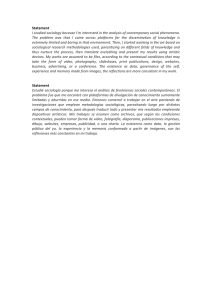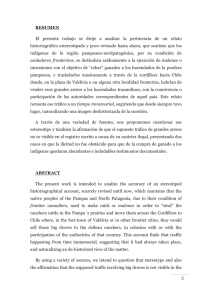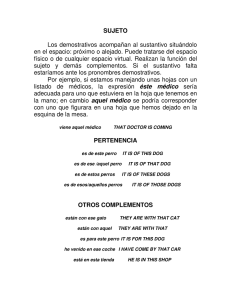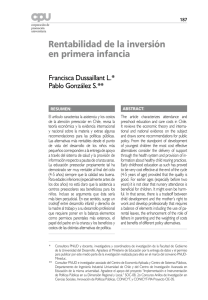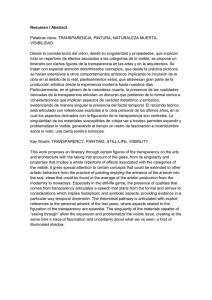Text / Texto / On the artistic production of Elke Krystufek and
Anuncio
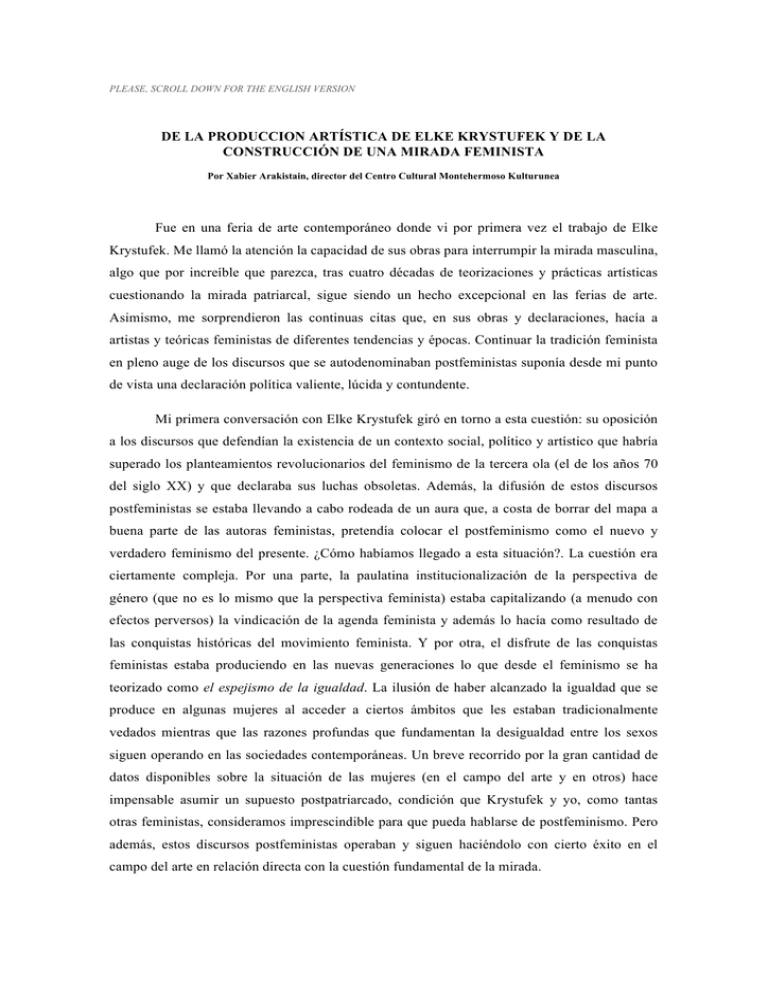
PLEASE, SCROLL DOWN FOR THE ENGLISH VERSION DE LA PRODUCCION ARTÍSTICA DE ELKE KRYSTUFEK Y DE LA CONSTRUCCIÓN DE UNA MIRADA FEMINISTA Por Xabier Arakistain, director del Centro Cultural Montehermoso Kulturunea Fue en una feria de arte contemporáneo donde vi por primera vez el trabajo de Elke Krystufek. Me llamó la atención la capacidad de sus obras para interrumpir la mirada masculina, algo que por increíble que parezca, tras cuatro décadas de teorizaciones y prácticas artísticas cuestionando la mirada patriarcal, sigue siendo un hecho excepcional en las ferias de arte. Asimismo, me sorprendieron las continuas citas que, en sus obras y declaraciones, hacía a artistas y teóricas feministas de diferentes tendencias y épocas. Continuar la tradición feminista en pleno auge de los discursos que se autodenominaban postfeministas suponía desde mi punto de vista una declaración política valiente, lúcida y contundente. Mi primera conversación con Elke Krystufek giró en torno a esta cuestión: su oposición a los discursos que defendían la existencia de un contexto social, político y artístico que habría superado los planteamientos revolucionarios del feminismo de la tercera ola (el de los años 70 del siglo XX) y que declaraba sus luchas obsoletas. Además, la difusión de estos discursos postfeministas se estaba llevando a cabo rodeada de un aura que, a costa de borrar del mapa a buena parte de las autoras feministas, pretendía colocar el postfeminismo como el nuevo y verdadero feminismo del presente. ¿Cómo habíamos llegado a esta situación?. La cuestión era ciertamente compleja. Por una parte, la paulatina institucionalización de la perspectiva de género (que no es lo mismo que la perspectiva feminista) estaba capitalizando (a menudo con efectos perversos) la vindicación de la agenda feminista y además lo hacía como resultado de las conquistas históricas del movimiento feminista. Y por otra, el disfrute de las conquistas feministas estaba produciendo en las nuevas generaciones lo que desde el feminismo se ha teorizado como el espejismo de la igualdad. La ilusión de haber alcanzado la igualdad que se produce en algunas mujeres al acceder a ciertos ámbitos que les estaban tradicionalmente vedados mientras que las razones profundas que fundamentan la desigualdad entre los sexos siguen operando en las sociedades contemporáneas. Un breve recorrido por la gran cantidad de datos disponibles sobre la situación de las mujeres (en el campo del arte y en otros) hace impensable asumir un supuesto postpatriarcado, condición que Krystufek y yo, como tantas otras feministas, consideramos imprescindible para que pueda hablarse de postfeminismo. Pero además, estos discursos postfeministas operaban y siguen haciéndolo con cierto éxito en el campo del arte en relación directa con la cuestión fundamental de la mirada. Los estudios feministas semiosiconalíticos que se popularizaron en la década de 1980 llegaban a la conclusión de que la mirada era una construcción cultural masculina inserta en un orden masculino y que tenía como finalidad perpetuar el orden patriarcal, a la vez que comenzaban a teorizar estrategias de resistencia y combate. Ya en 1975 Laura Mulvey en Visual Pleasure and Narrative Cinema proporcionaba las claves para la construcción de una mirada feminista con el objetivo de deconstruir y subvertir la mirada patriarcal, para lo que, al igual que Cook y Johnston, proponía el desarrollo de un cine “anti-cine” que evidenciase cómo se construye la mirada masculina. Paralelamente, desde finales de los años 1960, en el campo del arte (donde el anti-cine ha encontrado y encuentra cada vez más un cálido cobijo), varias generaciones de artistas mujeres han venido desarrollando una práctica artística feminista, que mayoritariamente ha perseguido esos mismos objetivos, y que en ese sentido se puede considerar un arte “anti-arte”. Un arte que precisamente constituye una contribución esencial a la empresa de la construcción de una mirada feminista. Pero, ¿a qué nos referimos exactamente con esa terminología?, ¿qué es la mirada feminista?. Esta cuestión ha venido orientando mis conversaciones con Krystufek, de la misma manera que nuestras prácticas en el arte, la suya como artista y la mía como comisario/gestor. Nuestras conversaciones sobre la mirada han consistido en repasar los diversos debates que se han llevado a cabo al respecto, dentro del feminismo para adoptar una interpretación de sus resultados que comparte un amplio sector teórico y artístico. Tomando como referencia el libro de Giulia Colaizzi La pasión del significante (2007) podríamos definir la mirada feminista como la mirada profunda que interrumpe la mirada masculina porque es capaz de ampliarla incluyendo múltiples lazos con la matriz socio-histórica e ideológica que la construye. Así, la mirada feminista sería la que visibiliza lo invisible, no sólo los planos descartados que han borrado a las mujeres de la historia, sino que además pone al descubierto el origen sociopolítico del propio acto de mirar. Desde esta perspectiva, gran parte del imaginario que producen o está siendo rescatado por los discursos postfeministas y postpornográficos no supera, porque no desafía, la mirada hegemónica masculina. Y este es un hecho que he podido constatar especialmente en los últimos dos años que llevo al frente del Centro Cultural Montehermoso a través de los diferentes programas expositivos y de difusión y debate intelectual que hemos desarrollado. Me refiero, en concreto, a ciertas prácticas de reapropiación del desnudo femenino pornográfico patriarcal a cargo de lo que se ha denominado “la” mirada lesbiana. Y es que parece tan problemático limitar una posible mirada lesbiana a este tipo de prácticas y perspectivas, como equiparar “esa” mirada lesbiana a una mirada feminista, aunque sea post. De hecho, esta cuestión también ha sido teorizada desde perspectivas feministas lesbianas en, por citar un ejemplo, The lesbian heresy. A feminist perspective on the lesbian sexual revolution (1993), obra en la que Sheila Jeffreys denuncia que, teniendo en cuenta el importante corpus de teoría feminista lesbiana original que podría servir de fuente para, sin abandonar el feminismo, crear una nueva teoría lesbiana, desde el primer momento los textos que sirvieron de base para los discursos postfeministas eliminaron a autoras como Mary Daly, Audre Lorde, Janice Raymond, Julia Penelope, Sara Hoagland o Charlote Bunch. Más aún, el despliegue de la perspectiva postpornográfica se ha realizado, no sólo ocultando a algunas autoras feministas, sino obviando o mutilando todo un debate del feminismo, el que en los años 1980 se produjo en torno a la pornografía y que, desde mi punto de vista, es esencial para abordar tanto la postpornografía como el postfeminismo. Una vez más, no se trata en absoluto de un nuevo intento para establecer los cánones que discriminarían entre las “buenas” y “malas” chicas según estas practiquen una sexualidad tachada de “correcta” o “incorrecta”, como ya se planteó en aquellos años, pero sí de, rescatar, al menos, las conclusiones más relevantes de aquel debate. Tal y como señala Raquel Osborne en La construcción sexual de la realidad (1993), por una parte, el feminismo “antipornografia” abogó por censurar materiales pornográficos, mientras que, por otra, el sector denominado “anticensura” proponía más bien una crítica cultural de la misma. Sin embargo, los discursos postpornográficos identifican el feminismo con las posturas del frente antipornografía y obvian las preguntas cruciales que, desde una posición anticensura, plantea Osborne: ¿cómo combinar la lucha contra los abusos sexuales masculinos con la libertad sexual de las mujeres? ¿Cómo podemos apoyar la libertad sexual sin legitimar por ello los aspectos más opresivos de la conducta sexual masculina?. Estas preguntas que abren una línea de investigación concreta siguen siendo pertinentes a la luz de los actuales discursos post, y además, la vía que trazan supone una vía alternativa a la post, una vía feminista. La teorización de la mirada feminista explica el “rechazo” que siguen despertando, tanto algunas de las imágenes del cuerpo femenino que viene produciendo el arte feminista, como los discursos artísticos revolucionarios feministas que no toman como referencia directa el cuerpo. Este “rechazo” indica que la versión no consumible por el deseo masculino del desnudo femenino y de la representación crítica del mundo desde la perspectiva feminista pasan, inevitablemente, por desafiar frontalmente el propio acto de mirar tal y como está instituido en las sociedades patriarcales. La producción artística de Elke Krystufek siempre ha buscado ese “rechazo” al aplicar los parámetros que, Mulvey (1975) recomendaba para el anti-cine feminista. Es decir, se ha ocupado de imposibilitar el placer visual narrativo hegemónico y de mostrar el sustrato ideológico de toda representación. Y lo ha hecho desplegando un sistema de crítica cultural que evidencia las complejas relaciones entre la esfera social, económica, política, artística, etc que perpetúan el patriarcado en cada momento histórico y que desarrolla la vía de investigación feminista de la que surgen las preguntas de Osborne. En TABOU TABOO, el proyecto de Krystufek para el pabellón austriaco, la artista da un giro en su carrera pasando de sus investigaciones del análisis sobre la construcción cultural de la femineidad, y sus análisis críticos sobre la representación de las mujeres, a las indagaciones feministas sobre la construcción cultural de la masculinidad, o mejor dicho, de las masculinidades. Un giro que constituye una denuncia del uso perverso que se ha venido haciendo desde diversos frentes del edificio teórico feminista sobre el género, al equiparar “género” a “mujer”, con la pretensión de limitar la aplicación del conocimiento feminista sobre la construcción cultural del sexo, el género y la sexualidad de la especie humana exclusivamente a la mitad de la especie, las mujeres. Para ello ha desplegado un gran dispositivo que, en las dos habitaciones del pabellón que le han asignado, funciona como una instalación. Las paredes están cubiertas de pinturas murales sobre las que, a su vez, cuelgan lienzos y dibujos de varones que interactúan con la proyección de un video en el fondo de una de las habitaciones. Una instalación que, deliberadamente, contextualiza unas piezas con otras para configurar una sintaxis que evite un relato lineal. Del mismo modo, el video TABOU TABOO-country of translation, que gira en torno a un diálogo entrecortado que parece contar la historia de una hija que ha sido violada por su padre, ha sido cuidadosamente realizado combinando una serie de recursos que impidan, tanto la ilusión realista, como la identificación emocional de la audiencia, propias del lenguaje fílmico tradicional. El título general del proyecto, el del video, y el de algunas de las pinturas y dibujos, (If Murnau, If The Gay Pavillion, If Joe Hoffmann wasn’t to pity, If you have unusual talents, etc,) forman una peculiar familia semántica que explora las posibilidades de la construcción cultural de las diversas identidades masculinas y sobre la relación de éstas con la sexualidad. Es más, el proyecto recupera una serie de autores y teorías de principios del siglo XX que fundamentaron las dos vías complementarias que sirvieron para demostrar el carácter cultural de la sexualidad: el psicoanálisis y la antropología social y cultural. Y atravesando la producción teórica, el proyecto revisita mitos y producciones artísticas, de la misma época, en torno a la (exotizada) libertad sexual. Es el caso del film Tabu. A story of the South Seas de Friedrich Wilhelm Murnau de 1931 (que ha servido a la artista como punto de partida del proyecto) o de la construcción, el mismo año, del pabellón de Austria de la Bienal de Venecia por el arquitecto Josef Hoffmann. Un film y un edificio, junto a discursos teóricos, asociados a la idea del sur como depositaria de fantasías placenteras y eróticas. Otro elemento significativo es la dualidad franco-anglófona del título (que incide en la colonización francesa de la Polinesia), así como las constantes alusiones en las obras a las problemáticas de la traducción que destacan la cuestión de la extranjería. Todas estas referencias, que se retroalimentan entre sí, son trituradas a través de la teoría feminista mediante el despliegue de técnicas artísticas contemporáneas para construir un artefacto expositivo que invoca constantemente a su proceso de producción. El previo a la instalación del pabellón, en el que la artista, partiendo de que, a menudo muchas mujeres se ven a sí mismas, o ven a otras mujeres, como víctimas y que sigue siendo poco habitual que las artistas “miren” al “otro” varón, se enfrentó a la tarea de seleccionar y contratar un modelo varón para realizar una pintura que detalla su análisis de la acción. Un proceso que no se ha cerrado, ya que en su última etapa Krystufek abarca sus temas a través de varias exposiciones siguiendo una lógica de creación artística que supera las imposiciones expositivas externas. TABOU TABOO aborda a través de la mirada feminista el papel de la sexualidad en la constitución de la ley patriarcal y la red teórica, política y artística que la sostiene. Una mirada que, a juzgar por la proliferación de grupos de hombres por la igualdad, está produciendo entre los varones el mismo efecto liberador que ha producido y produce la conciencia feminista entre las mujeres. Junio de 2009 Publicado en: Elke Krystufek. Dorit Margreiter. Franziska & Lois Weinberger Österreich Pavillon, 53. Internationale Kunstausstellung − La Biennale di Venezia 2009 Edited by VALIE EXPORT und Silvia Eiblmayr Verlag der Buchhandlung Walther König, Köln, 2009 ON THE ARTISTIC PRODUCTION OF ELKE KRYSTUFEK AND THE CONSTRUCTION OF A FEMINIST GAZE By Xabier Arakistain, Director of the Centro Cultural Montehermoso Kulturunea It was at a contemporary art fair when I saw work by Elke Krystufek for the first time. I was struck by the immediate power her works had to interrupt the male gaze, which, however incredible it may seem, after four decades of theorisations and artistic practices questioning the patriarchal gaze, continues to be an exception at art fairs. I was similarly surprised by the constant references she made, in her works and declarations, to feminist artists and theoreticians from different tendencies and periods. To continue the feminist tradition when self-declared post-feminist discourses were in full spate represented, from my perspective, a courageous, lucid, forceful political declaration. My first conversation with Elke Krystufek revolved around this question: her opposition to discourses that upheld the existence of a social, political and artistic context that had superseded the revolutionary positions of the third wave of feminism (that of 1970s) and that pronounced their struggles as obsolete. What is more, these post-feminist discourses were being circulated under a surrounding aura that, at the expense of wiping a good deal of feminist authors off the map, was out to situate post-feminism as the real new feminism of the present. How had we reached this situation? The question was certainly complex. On the one hand, the gradual institutionalisation of the gender perspective (which is not the same as the feminist perspective) was capitalising (often with perverse effects) on the vindication of the feminist agenda and doing so as a result of the historic conquests of the feminist movement. And, on the other hand, enjoyment of these conquests was setting off in the new generations what has been theorised in feminism as the mirage of equality: the illusion of having achieved equality that some women experience on gaining access to particular areas that they used to be traditionally barred from, whilst the profound causes that underpin inequality between the sexes continue to operate in contemporary societies. A brief run through the enormous amount of information available concerning women’s situation (in the art field and in other fields) make it unthinkable to assume the existence of a supposed post-patriarchy, a condition that Krystufek and I, along with so many other feminists, consider to be indispensable if we are to talk of post-feminism. But, in addition, these post-feminist discourses were operating and continue to do so with some success in the art field in direct relation with the fundamental question of the gaze. The semi-psychoanalytic feminist studies that became popular in the 1980s reached the conclusion that the gaze was a male cultural construction built within a male order whose purpose was to perpetuate the patriarchal order, and accordingly they began to theorise strategies of resistance and combat. Back in 1975 Laura Mulvey, in Visual Pleasure and Narrative Cinema, provided the keys for the construction of a feminist gaze aimed at deconstructing and subverting the patriarchal gaze, for which she proposed, along with Cook and Johnston, the development of “counter-cinema” to highlight the way in which the male gaze is constructed. In parallel, since the end of the 1960s, within the art field (where counter-cinema found and increasingly finds the warmth of shelter), various generations of women artists have been developing a feminist artistic practice which has in the main pursued the same objectives, and which may in this sense be considered as “counter-art”. It is an art that constitutes an essential contribution to the task of constructing a feminist gaze. But what exactly are we referring to with this terminology? What is the feminist gaze? This question has been guiding my conversations with Krystufek, as have our practices in art: hers as an artist and mine as a curator/agent. Our conversations about gaze have consisted of a review of the different debates that have taken place around this topic within feminism and led us to an interpretation of their results that is shared by an ample theoretical and artistic sector. Taking as reference the book La pasión del significante by Giulia Colaizzi (2007), we could define the feminist gaze as the deep gaze that interrupts the male gaze because it is capable of widening to include multiple bonds with the socio-historic matrix and the ideology that constructs it. The feminist gaze is that wich makes the invisible visible, beyond recovering the discarded takes that have erased women from history, since it also exposes the socio-political origin of the very act of looking. From this perspective, a good deal of the imaginary that is produced or is being recovered by post-feminist and post-pornographic discourses does not overcome the male hegemonic gaze, because it does not defy it. And I have been able to confirm this over the last two years while I have been in charge of the Centro Cultural Montehermoso, through the different programmes of exhibitions, and intellectual diffusion and debate that we have organised. I am referring to particular practices involving the re-appropriation of the patriarchal pornographic female nude by what has been termed “the” lesbian gaze. It seems as problematic to limit a possible lesbian gaze to these kinds of practices and perspectives, as to liken “that” lesbian gaze to a feminist gaze, however ‘post’ it may be. In fact, this question has already been theorised from lesbian feminist perspectives in, for example, Sheila Jeffreys’ work The lesbian heresy. A feminist perspective on the lesbian sexual revolution (1993). Here she denounces the fact that, bearing in mind the important corpus of original lesbian feminist theory that might serve as a source for the creation of a new lesbian theory, without abandoning feminism, authors such as Mary Daly, Audre Lorde, Janice Raymond, Julia Penelope, Sara Hoagland and Charlotte Bunch were eliminated from the founding texts that drove for post-feminist discourses. But in addition, the unfolding of the post-pornographic perspective has not only concealed some feminist authors, but has avoided or mutilated a whole debate in feminism which took place in the 1980s around pornography. From my point of view, that debate is essential if post-pornography and post-feminism are both to be tackled. Once again, this is absolutely not a new attempt at issuing canons that would discriminate between “good” and “bad” girls on lines of whether they practice a sexuality branded as “correct” or “incorrect”, as it was posed in those years, but it is necessary to at least recover the most relevant conclusions of that debate. As Raquel Osborne also explains in The sexual construction of reality, (1993), on the one hand, ‘anti-pornography’ feminism fought for censorship of pornographic material, while, on the other, the so-called ‘anti-censorship’ sector proposed instead a cultural critique of it. Nevertheless, post-pornographic discourses identify feminism with the positions of the antiporn front and avoid the crucial questions that Osborne put forward, from the anti-censorship posture: how do we combine the fight against male sexual abuses with the sexual freedom of women? How can we support sexual freedom without thereby legitimising the most oppressive aspects of male sexual conduct? These questions that open up a line of concrete research continue to be pertinent in the light of current ‘post’ discourses and, furthermore, the path they trace offers an alternative route to that indicated by ‘post’ approaches. It is a feminist path. Theorisation of the feminist gaze explains the ‘rejection’ that continues to be aroused both by some of the images of the female body that feminist art is producing, and by revolutionary feminist artistic discourses that do not take the body as a direct reference. This ‘rejection’ indicates that the version of the female nude and of the critical representation of the world from the feminist perspective, unconsumable by male desire, inevitably involves a frontal challenge to the very act of looking as it is instituted in patriarchal societies. The artistic production of Elke Krystufek has always sought that ‘rejection’ through application of the parameters Mulvey (1975) recommended for feminist counter-cinema. She has taken measures to cut off hegemonic narrative visual pleasure and to show the ideological substratum of any representation. And she has done it by deploying a system of cultural critique that reveals the complex relations between the social, economic, political, artistic and other spheres that perpetuate the patriarchy at each historic moment, and that is developed by the line of feminist investigation from which Osborne’s questions emerge. In TABOU TABOO, Krystufek’s project for the Austrian pavilion, the artist makes a turn in her career by shifting her investigations of the analysis of the cultural construction of femininity, and her critical analyses concerning the representation of women, in order to develop feminist investigations around the cultural construction of masculinity or, more exactly, of masculinities. This turn constitutes a denunciation of the perverse use that has been made, from different quarters, of the feminist theoretical edifice concerning gender, making ‘gender’ synonymous with ‘women’, with the intention of limiting the application of feminist knowledge regarding the cultural construction of sex, gender and the sexuality of the human species to just half of the species, to women. For this purpose she has unfolded a complex device, in the two rooms she has been assigned in the pavilion, which functions as an installation. The walls are covered by mural paintings upon which, in turn, are hung canvasses and drawings of males who interact with the projection of a video at the end of one of the rooms. It is an installation that, deliberately, contextualises some pieces with others to configure a syntax that avoids a linear story. Similarly, the video TABOU TABOO-country of translation, which revolves around a faltering dialogue that appears to tell the story of a daughter who has been raped by her father, has been carefully executed, combining a series of resources that block both the realist illusion and emotional identification of the audience that are proper to traditional film language. The general title of the project, that of the video, and those of some of the paintings and drawings (If Murnau, If The Gay Pavilion, If Joe Hoffmann wasn’t to pity, If you have unusual talents, etc,) form a peculiar semantic family that explores the possibilities of the cultural construction of diverse male identities and their relation with sexuality. What is more, the project recovers a series of authors and theories from the beginnings of the 20th century that laid the foundations for the two complementary avenues that served to demonstrate the cultural nature of sexuality: psychoanalysis and social and cultural anthropology. And running through the theoretical production, the project revisits myths and artistic productions, from the same period, in relation with (exoticised) sexual freedom. This is the case of the film, from 1931, Tabu. A story of the South Seas by Friedrich Wilhelm Murnau, (which served the artist as the project’s point of departure), or of the construction, the same year, of the Austrian pavilion at the Venice Biennale, by architect Josef Hoffmann. A film and a building, along with theoretical discourses, associated with the idea of the South as a repository of pleasure and erotic fantasies. Another significant element is the French-Anglophone duality of the title (which touches on the French colonisation of Polynesia), as well as the constant allusions in the works to the problematics of translation that highlight the question of alien status. All these references, interacting with one another, are blasted by feminist theory via the deployment of contemporary artistic techniques which construct an exhibition artefact that constantly invokes its production process. The preliminary to the installation of the pavilion was that the artist, starting out from the fact that many women often see themselves, or see other women, as victims, and that it continues to be rather unusual for women artists to “look” at the male “other”, set herself the task of selecting and contracting a male model to make a painting that details her analysis of the action. This is a process that has not yet concluded since of late Krystufek deals with her themes through various exhibitions following a logic of artistic creation that goes beyond external exhibition impositions. Through the feminist gaze, TABOU TABOO tackles the role of sexuality in the constitution of patriarchal law and the theoretical, political and artistic network that upholds it. This gaze, to judge by the proliferation of groups of men for equality, is having the same liberating effect upon men that feminist consciousness aroused and arouses among women. June 2009 Published in: Elke Krystufek. Dorit Margreiter. Franziska & Lois Weinberger Österreich Pavillon, 53. Internationale Kunstausstellung − La Biennale di Venezia 2009 Edited by VALIE EXPORT und Silvia Eiblmayr Verlag der Buchhandlung Walther König, Köln, 2009


